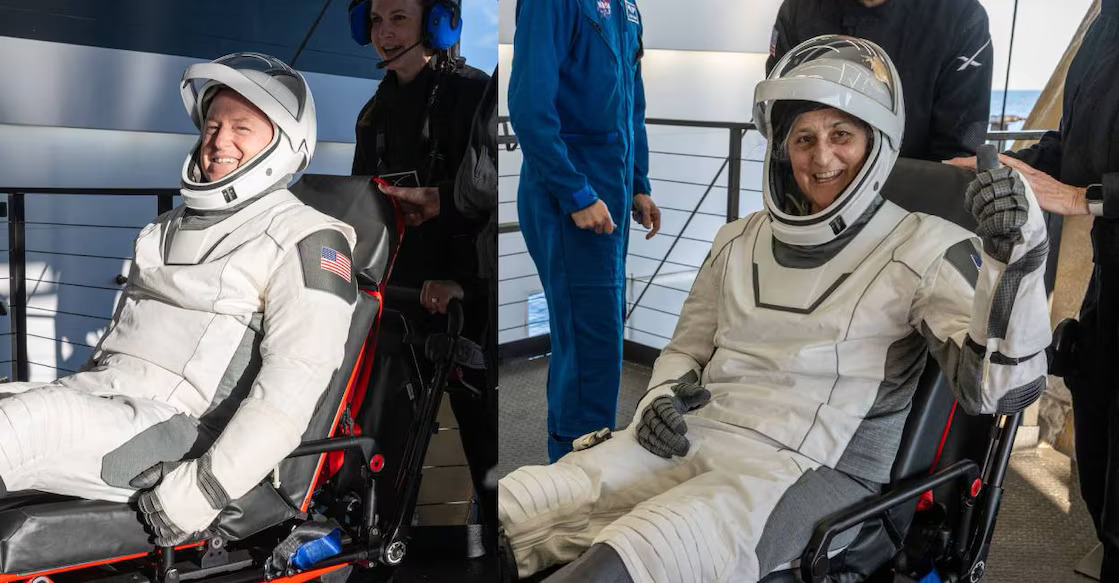Homecoming After an Unexpectedly Long Stay
NASA astronauts Sunita Williams and Butch Wilmore have finally returned to Earth after an unexpected nine-month stay in space, concluding a mission that captivated global attention and ignited political debates. The SpaceX Crew Dragon capsule, named Freedom, safely splashed down off the coast of Florida on March 18, 2025, at 5:57 PM (2157 GMT), marking the end of their prolonged space journey.
The capsule, charred from enduring scorching 3,500-degree Fahrenheit (2,000°C) re-entry temperatures, was met with cheers from NASA ground teams. As the spacecraft bobbed on the waves, a playful pod of dolphins made a surprise appearance, adding a poetic touch to the historic return.
Why Were the Astronauts Stranded in Space?
Wilmore and Williams, both veteran ex-Navy pilots, were initially launched in June 2024 aboard Boeing’s Starliner on a short test mission to the International Space Station (ISS). However, propulsion system malfunctions rendered the spacecraft incapable of bringing them back, forcing an unplanned extension of their stay.
NASA later reassigned them to SpaceX’s Crew-9 mission, which arrived in September 2024 with a reduced crew to accommodate the stranded astronauts. With Crew-10 docking on Sunday, March 17, 2025, Williams and Wilmore were finally cleared to return.
The SpaceX Crew Dragon Splashdown
Accompanying Williams and Wilmore on their return were fellow American astronaut Nick Hague and Russian cosmonaut Aleksandr Gorbunov, who had also completed their ISS rotations. After a 17-hour journey from the ISS, the Crew Dragon capsule deployed its parachutes, ensuring a gentle splashdown in the Atlantic Ocean.
Recovery teams swiftly hoisted Freedom aboard a recovery vessel, where medical personnel assisted the astronauts onto mobility aids—a common procedure after long-duration space travel due to muscle and bone loss, vision issues, and balance adjustments.
NASA Astronauts’ Health and Next Steps
The extended space mission—286 days—while exceeding the typical six-month ISS rotation, still ranks sixth among the longest US space missions. The current US record belongs to Frank Rubio, who spent 371 days in space, while the global record is held by Russian cosmonaut Valeri Polyakov at 437 days.
Despite the challenges, medical experts believe Williams and Wilmore’s health risks remain manageable. They will now be flown to Houston for family reunions and physical rehabilitation before resuming normal activities.
Political Controversy: Trump vs. Biden Administration
The unexpected delay in their return became a political flashpoint in the United States. The White House claimed credit, posting on X (formerly Twitter):
“PROMISE MADE, PROMISE KEPT.”
The statement suggested that former President Donald Trump’s administration had accelerated the recovery timeline—a claim criticized by NASA experts.
Trump and his close ally, SpaceX CEO Elon Musk, accused President Joe Biden of abandoning the astronauts and delaying their return. However, NASA’s Commercial Crew Program Manager, Steve Stich, dismissed the claims, confirming that the plan for their return had remained unchanged since their reassignment to Crew-9.
Trump’s Controversial Remarks on Sunita Williams
Trump’s comments about Sunita Williams raised further eyebrows. At a White House press event, he referred to the seasoned astronaut as:
“The woman with the wild hair.”
He also speculated about the dynamics between Wilmore and Williams, making an off-hand remark:
“They’ve been left up there—I hope they like each other, maybe they love each other, I don’t know.”
Such remarks drew backlash from the space exploration community, emphasizing the astronauts’ professionalism and dedication to their mission.
The Future of NASA’s Human Spaceflight
While Williams and Wilmore’s return marks the end of one chapter, NASA continues to push the boundaries of human space exploration. With upcoming Artemis missions, the agency is gearing up for a new era of deep-space exploration, including the Moon and Mars.
The mission also highlighted the critical role of private companies like SpaceX and Boeing in NASA’s evolving commercial crew program. However, Boeing’s Starliner setback has raised concerns, putting further pressure on the company to deliver a reliable spacecraft.
Conclusion
Sunita Williams and Butch Wilmore’s prolonged mission stands as a testament to human resilience, teamwork, and technological progress. Their safe return not only ends months of uncertainty but also paves the way for NASA’s future missions to space.
With political debates still swirling, one fact remains clear: NASA’s mission is to explore, innovate, and return safely—no matter the obstacles.
YAllA TV – www.yallatv.ae





